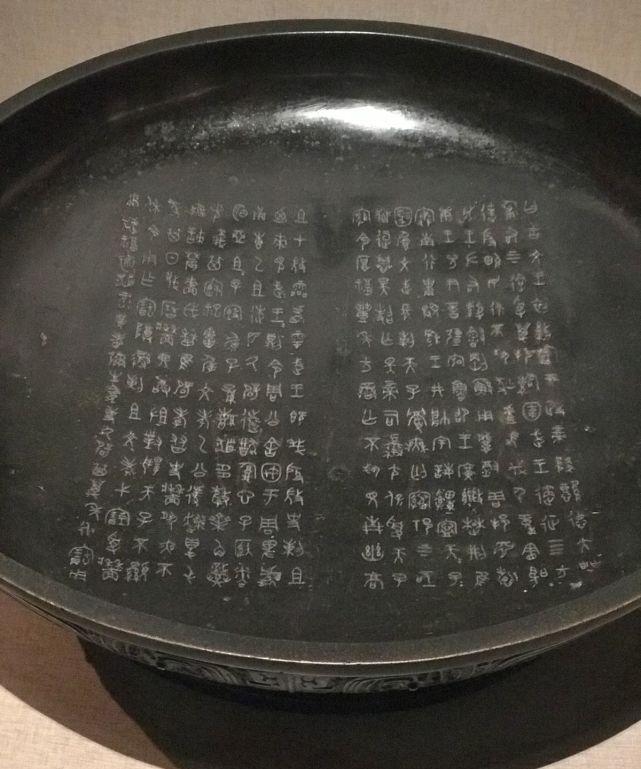There are two bronze plates in the exhibition "Zhaozi China - Bronze Ware and Golden Essence Unearthed in Baoji" held by the National Museum, both of which are forbidden to go abroad (border) to exhibit cultural relics, the former is the first batch, and the latter is the third batch.
It is not possible to go abroad to exhibit, which can be seen that it is a precious treasure of the country!
There are many bronzes in the Shang Zhou Dynasty, and those who can enjoy the "forbidden to go abroad" treatment must have more advantages than other bronzes. Both bronze plates have large inscriptions, and the bottom of the historical wall plate is cast with an inscription of 284 characters, praising the merits of the seven zhou kings of Zhou, Wu, Cheng, Kang, Zhao, Mu, and Gong (Gong); the plate has a 372-word inscription, recording the Wenzhi martial arts of 12 Zhou kings from King Wen of Zhou to King Xuan of Zhou for more than 200 years.
The lineages and "major merits" of the kings of the Western Zhou Dynasty recorded on the two bronze plates are very consistent with the records of the "Records of History", which is really a good book!
【History Wall Disk】
The disc is a water vessel, which is generally used in conjunction with the za, and is used for the ancient people to perform the ritual of fertility.
The Shi Wall Plate was excavated from the Zhuangbai No. 1 Cellar and cast during the Reign of the Western Zhou Dynasty, and was made by a man named Wall in the Wei family of the Western Zhou Dynasty to commemorate his ancestors.

In the middle of the Western Zhou Dynasty, the historical wall plate, the collection of the Baoji Zhouyuan Museum.
The folding of the album unearthed in the same cellar is also shiny, and so is this one. It can be seen that the surface treatment of bronze was very mature at that time. Bronze is said to be auspicious, and it is supposed to be bright gold. The surface of oxidation will have a patina for a long time. This kind of black should have been surfaced. The conjecture is the formation of a dense layer of oxide. It is black and prevents further oxidation.
The outer wall ornament is the most popular and characteristic ornament of the Western Zhou Dynasty.
The first half of the inscription records the important political achievements of the kings of Western Zhou, Wu, Cheng, Kang, Zhao, and Mu, and the second half records the family history of the Wei family to which the wall belongs.
【Disc】
Yi Pan, the National Expo "House In China" exhibition wrote 逑 plate, but in the "Birthplace" Baoji Bronze Museum wrote "逨 Pan". Check it repeatedly, it is the same bronze plate. Why the two names, know the advice.
Because it is a national exhibition, it is written according to the name given by the national exhibition.
Yipan, late Western Zhou Dynasty, has the reputation of "bronze history book", excavated in 2003 in Yangjia Village, MeiXian County. The inscription cast on the bottom of the plate is 372 words. The deeds of 12 Zhou kings from King Wen to King Xuan are listed one by one, with a time range of more than 200 years, which can be called a minimalist history of the Western Zhou Dynasty.
Late Western Zhou Dynasty, Baoji Bronze Museum Collection.
The vessel is beautifully shaped, the abdomen and the foot of the circle are decorated with a stolen pattern, the head is a ring of the head of the beast, and the outside of the disc is covered with emerald green patina. It is the most historically valuable bronze vessel excavated from the cellar of Yangjia Village.
The inscription cast on the plate is 21 lines and 372 words, which details the history of the 8 generations of the Shan family assisting the Western Zhou Dynasty from King Wen to King Xuan for 12 generations of Tianzi to conquer, govern and govern Linze.
In the middle of the two appendages of the body, there are two head of the ring that are opposite to each other.
The inscription is dignified and the layout is regular.
The first half of the inscription is that the Western Zhou nobleman Shan Yi counts in the first person the deeds of eight generations of Shan clan people, including himself, serving the Western Zhou Tianzi, and at the same time lists the deeds of the 12 Zhou kings from King Wen to King Xuan, including Wen Zhi Wu, one by one, with a time range of more than 200 years. In the second half of the inscription, the King of Zhou sealed Shan Yi and rewarded Shan Yi with gratitude for the kindness of the Son of Heaven, casting vessels to comfort the ancestors.
Recommended related reading:
Guobo: Recognize words, but do not necessarily know the "self" on bronze
Hubei Province Bo: Porcelain from the Song Dynasty and Ming Dynasty, not very exciting
Su Bo: The good stuff unearthed from the Ruiguang Temple Pagoda